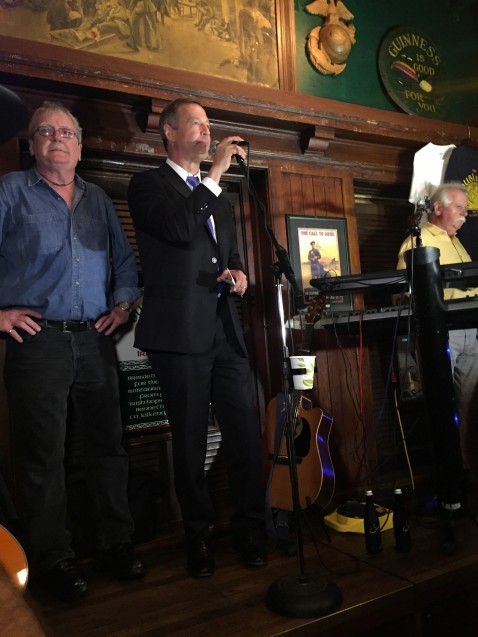WASHINGTON — The 2016 election is on November 8, exactly one year from Sunday. In recent weeks, the Democratic field has been whittled down to three candidates as Jim Webb, Lincoln Chafee and Lawrence Lessig all dropped out of the race for the nomination.
The remaining candidates, Hillary Clinton, Bernie Sanders and Martin O’Malley, will participate in a South Carolina forum hosted by MSNBC’s Rachel Maddow Friday night.
The Republican field has been slower to narrow, with 15 of the original 17 candidates still in the race. Rick Perry and Scott Walker both dropped out in September.
At the one-year out mark of the 2008 cycle, there were still 8 eight candidates running for president on the Democratic side and eight on the Republican side.
Looking at where the candidates stood at that point, who led in the polls and how they fared in the spring, can give meaningful context to the current state of the primaries and provides clues about whether polls so far from balloting are good predictors of actual results.

In early November 2007, then-Sen. Clinton held a strong lead of 19 percentage points over fellow Sen. Barack Obama, according to a CNN poll. Shortly after, she fell in the polls and came in third in the Jan. 1 Iowa caucuses , with Obama and former Sen. John Edwards ahead of her.
In this month’s latest polls, Clinton has maintained a wide gap over Sanders, the senator from Vermont, and O’Malley, the former Maryland governor. The latest NBC/WSJ poll had Clinton at 63 percent nationally, with Sanders at 31 percent and O’Malley at 3 percent. This time around, the Iowa caucuses are later, on Feb. 1, giving Clinton’s competitors more time to catch her than Obama had.
History suggests Sanders has some hope of bridging the gap, but a closer look at the numbers reveals some more discouraging trends for the lawmaker.
“Obama had much broader appeal in ‘08 than Sanders does,” Brookings Institution fellow John Hudak said. “He’s pulling 10 percent of the African American vote, doing very poorly among Latinos. You don’t become the Democratic nominee without winning a much higher percentage of black and Latino voters than Sanders is.”
The 2008 comparison is even more discouraging for O’Malley. Four of the five candidates polling around 3 percent at this point in 2007 dropped out by the end of January 2008.
Among them was then-Sen. Joe Biden, who had hovered around 3 percent before suspending his campaign on Jan. 3. Biden would go on to be tapped as Obama’s nominee for vice president, an outcome some have speculated might also be in store for O’Malley.
“He’s running a campaign that would position him well to become a vice president or to take a cabinet position,” Hudak said. “He’s been certainly critical of his opponents and Secretary Clinton especially, but he hasn’t run a negative campaign. He’s doing the right things to stay relevant beyond the presidency and that’s working well for him.”
O’Malley on Wednesday became the first Democratic candidate to sign up for the New Hampshire primary, suggesting he has no plans of dropping out before February.
“There are many examples in the history of our country where a candidate who had 1 or 2 or 3 percent national name recognition suddenly emerged on caucus night and was introduced to the rest of the country,” O’Malley told reporters at an Irish Americans for O’Malley campaign event in Washington Thursday night. “Most people in Iowa don’t make up their minds to the last couple of weeks but the opinion leaders are making up their minds now and after that last JJ many of them started breaking our way so I couldn’t be more encouraged I couldn’t be more excited.”
Hudak said he believes O’Malley will stay in the race as long as he has the fundraising to continue. This poses a problem for the ex-governor, who had just over $800,000 cash on hand at the end of September.
Two of the similarly low-polling candidates in 2008, Biden and former New Mexico Gov. Bill Richardson, had $1.9 million and $5.8 million, respectively, remaining in their campaign chests as of Oct. 1, 2007. Both candidates bowed out of the race in early January 2008.
On the Republican side, businessman Donald Trump and neurosurgeon Ben Carson sit atop the field. Hudak said he has been surprised at their continuing popularity, but still doesn’t believe either of them will win the nomination.
“It’s hard to see one of them becoming the nominee,” Hudak said. “The money forces which can really drive the nomination I don’t think have stepped in as strong as they can yet. When those forces come in, I think you’re going to see a more establishment candidate rise.”
In the last two Republican primaries, the frontrunner at this time also did not go on to get the nomination. In 2008, former New York City Mayor Rudy Guiliani held a 12-point lead, and in 2012, businessman Herman Cain held a slight lead over former House Speaker Newt Gingrich. But in 2008, Arizona Sen. John McCain surged to the nomination, and four years later former Massachusetts Gov. Mitt Romney ended up the GOP standard-bearer.


You must be logged in to post a comment.